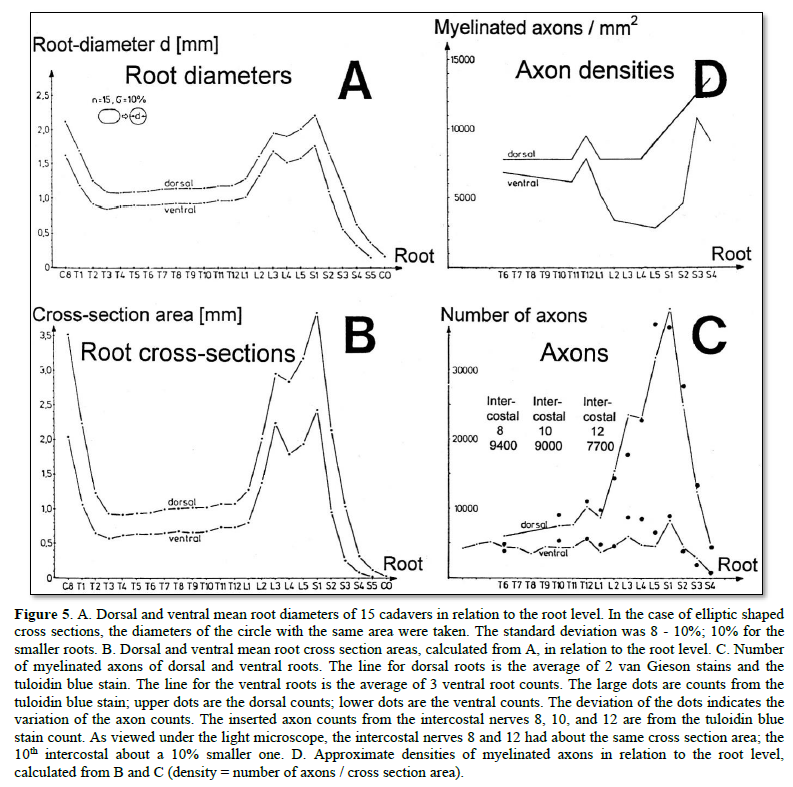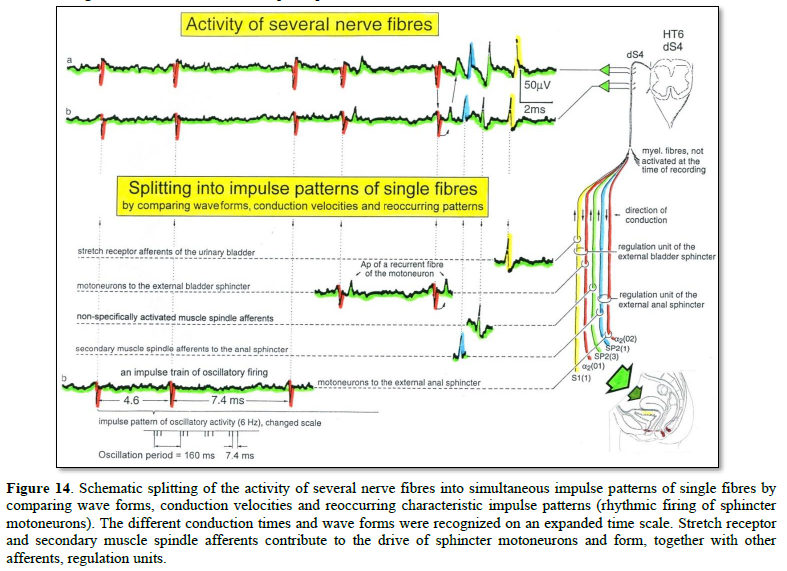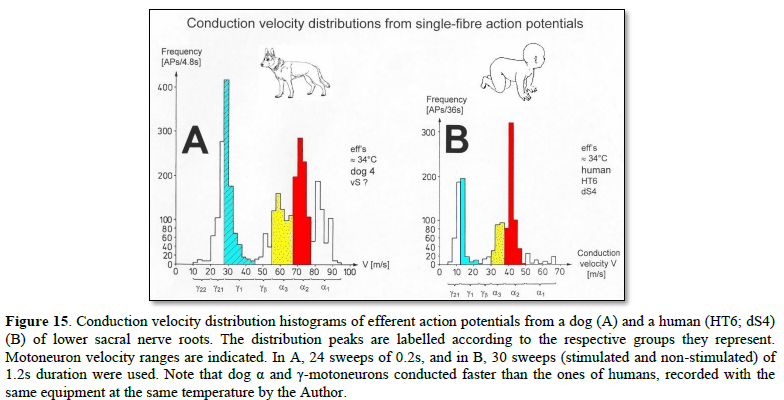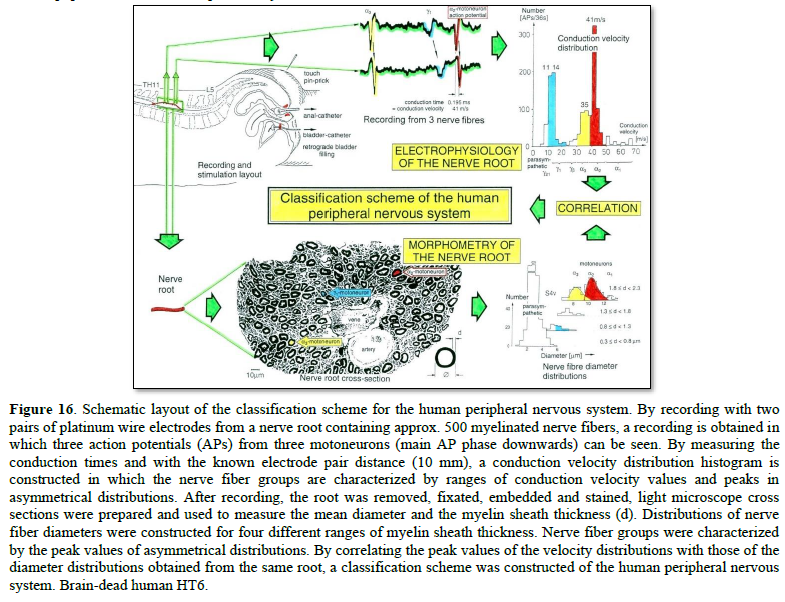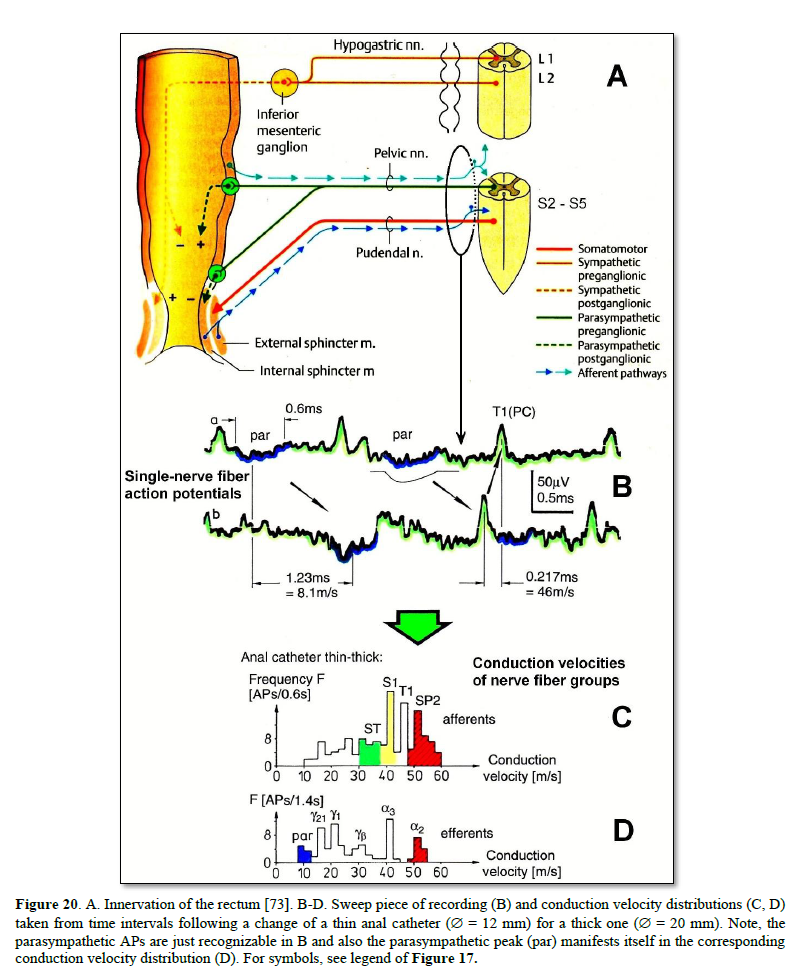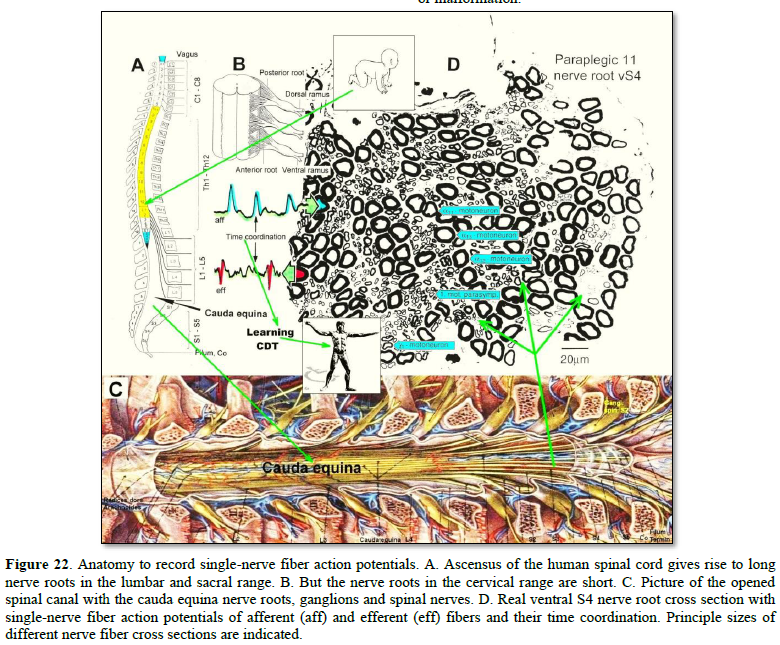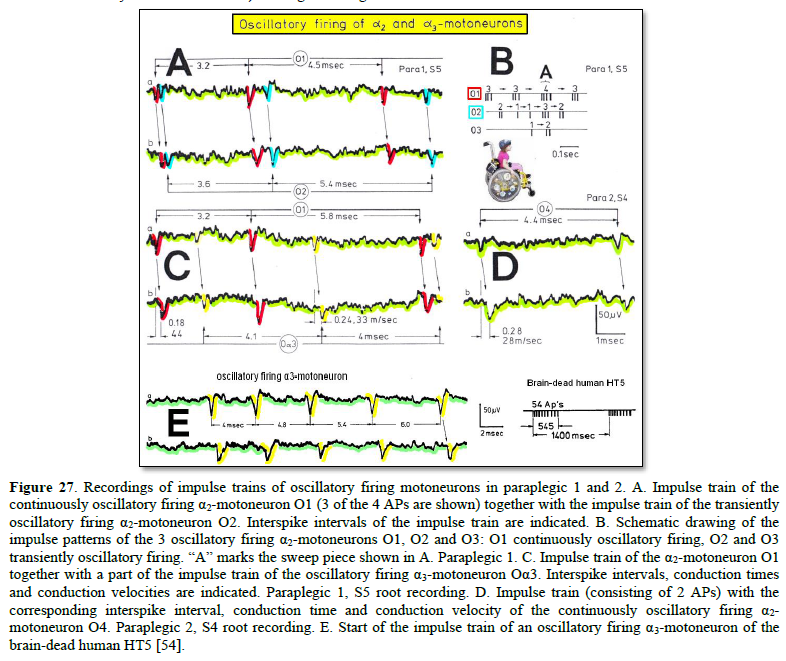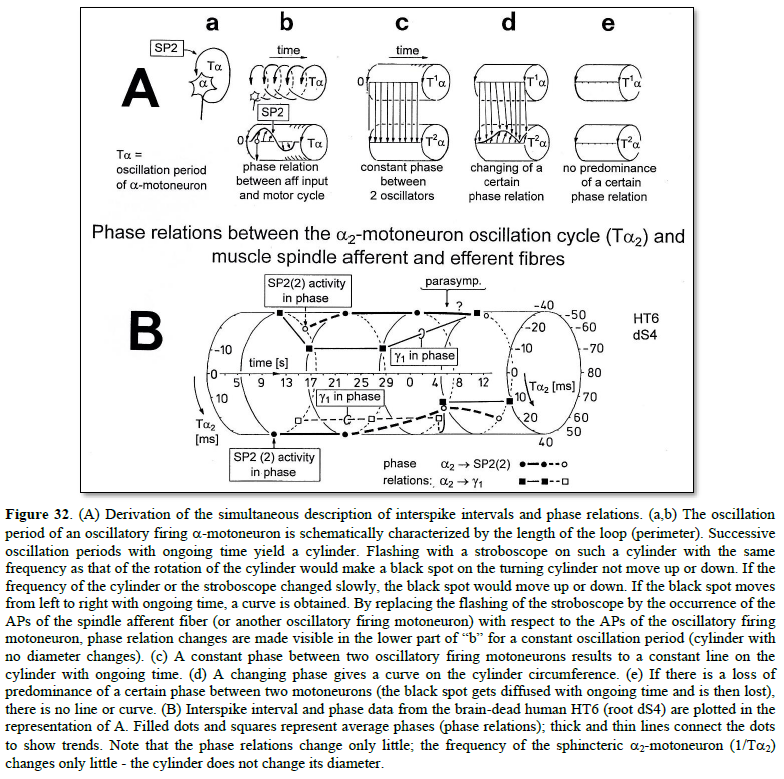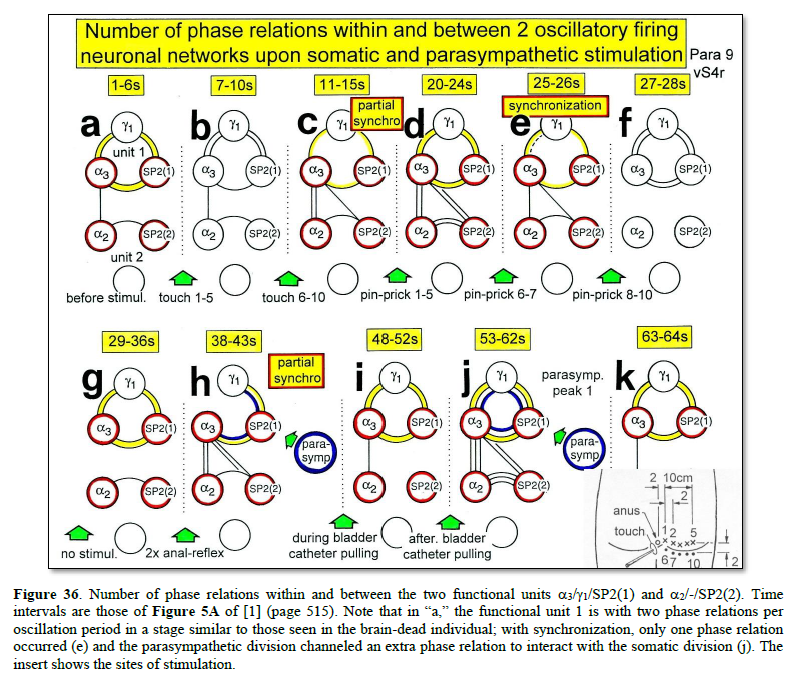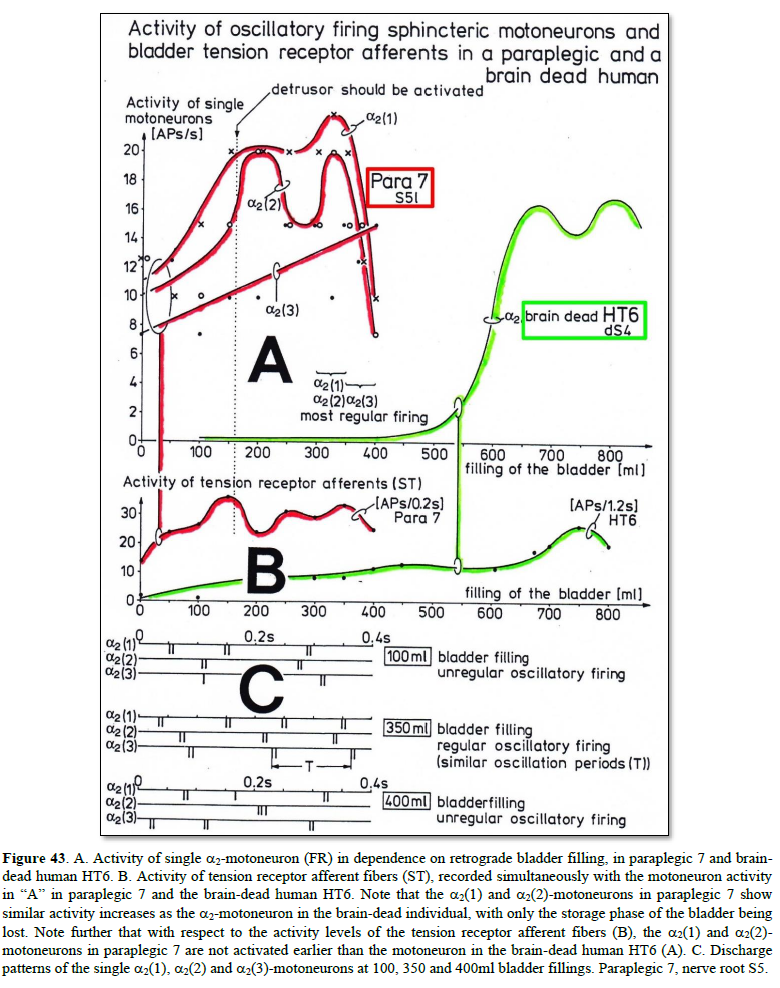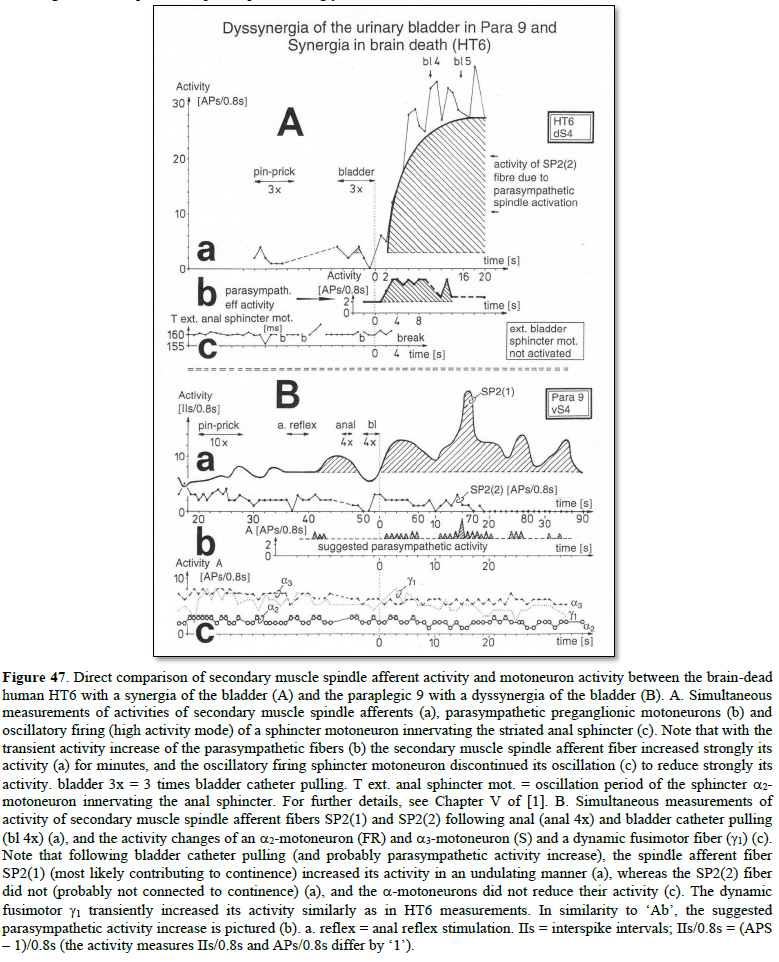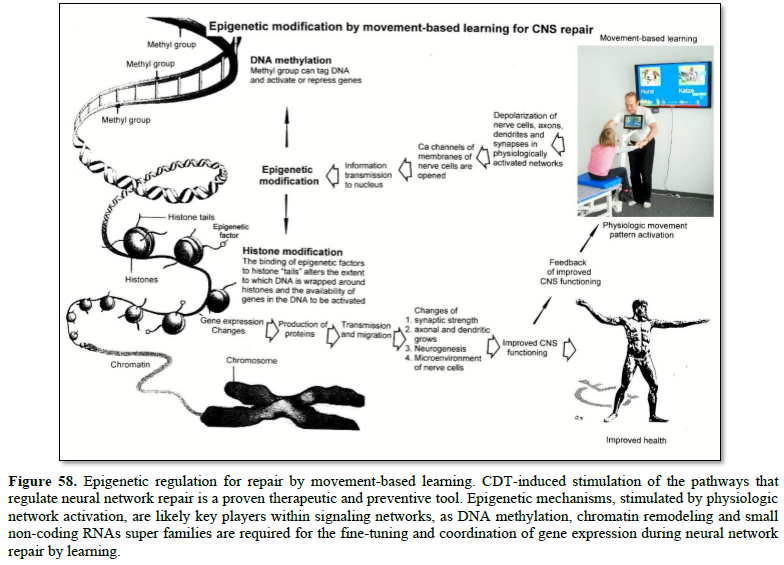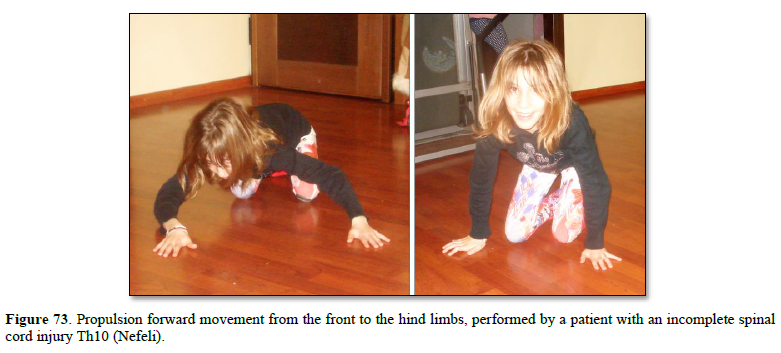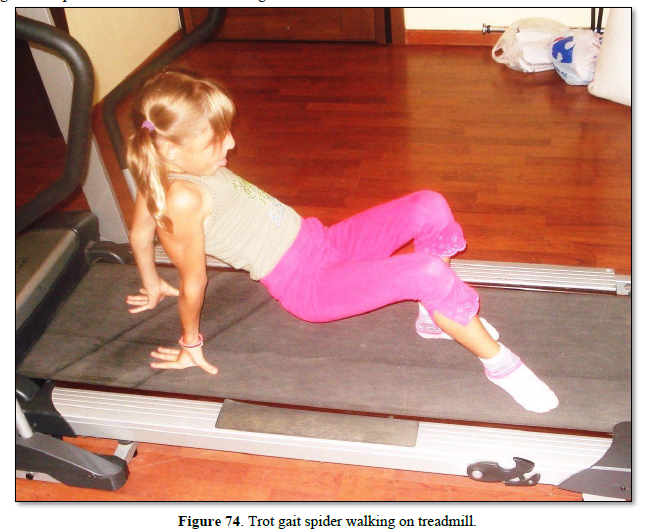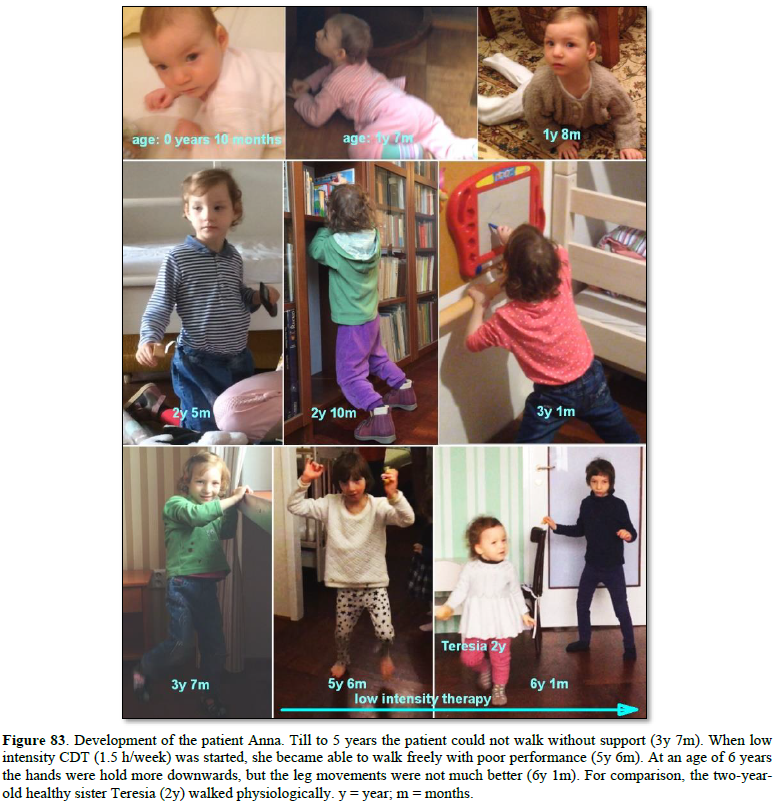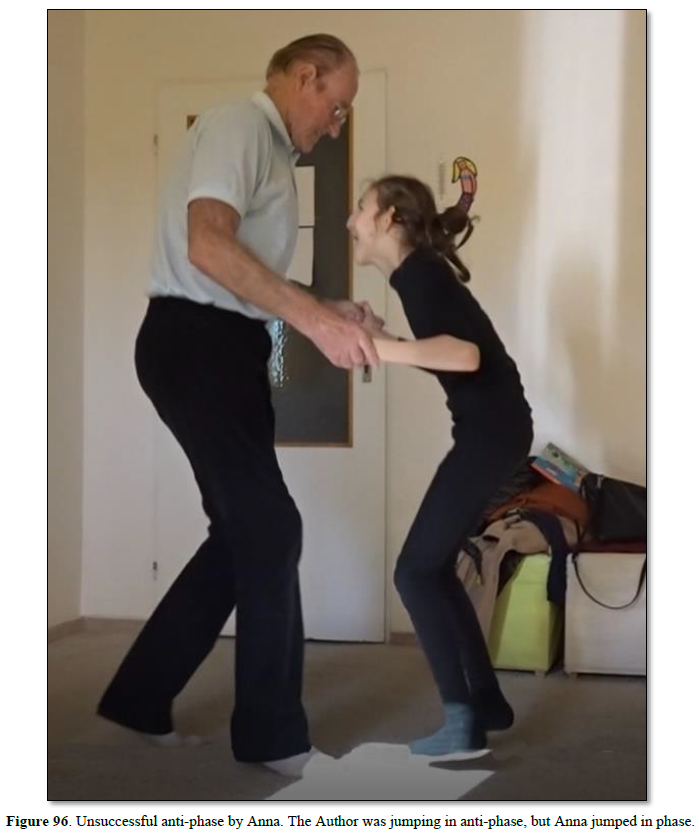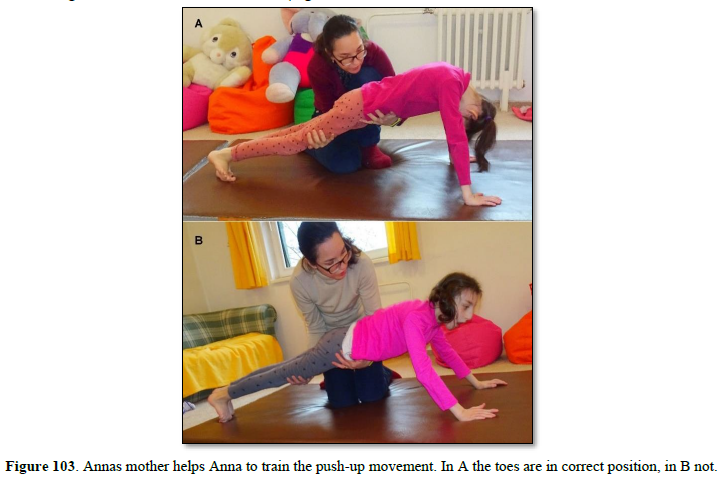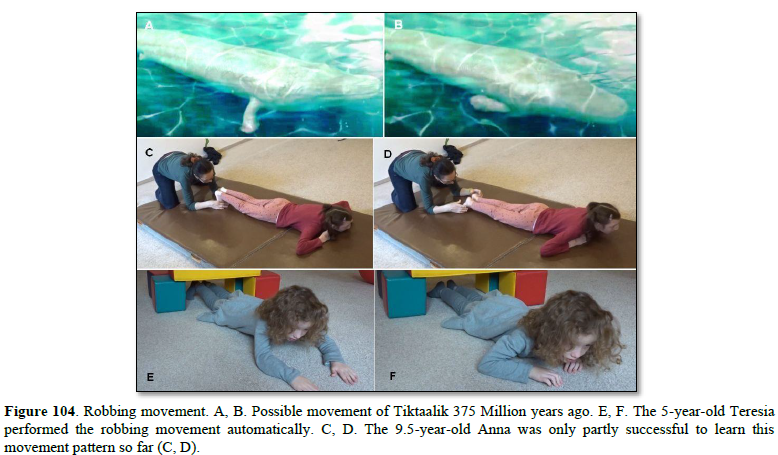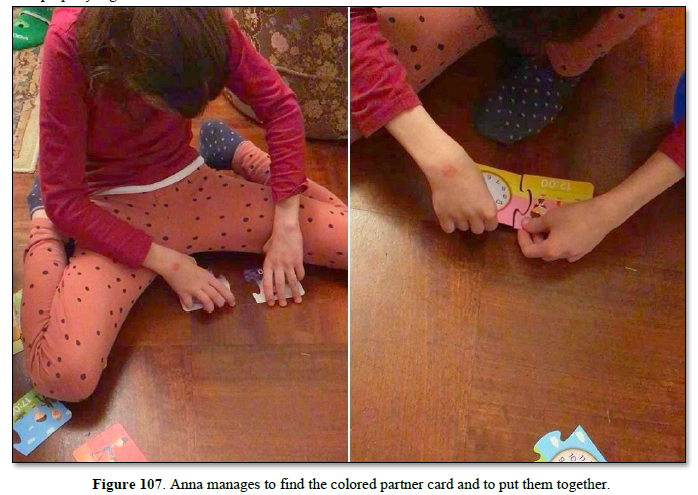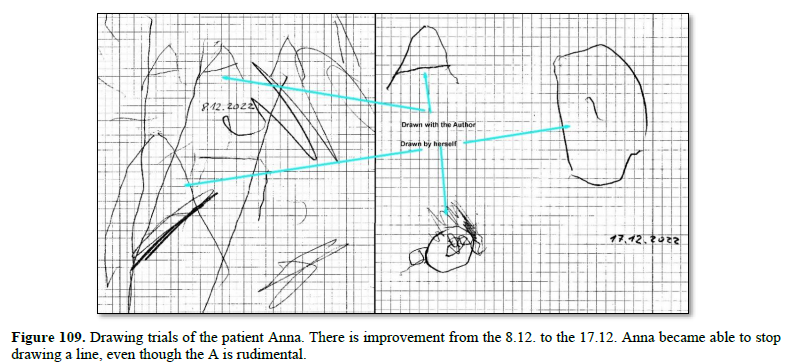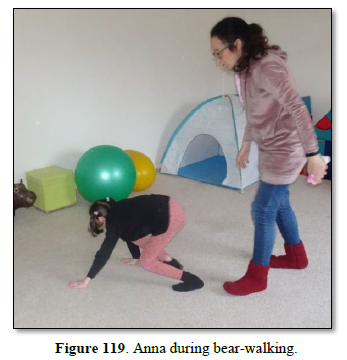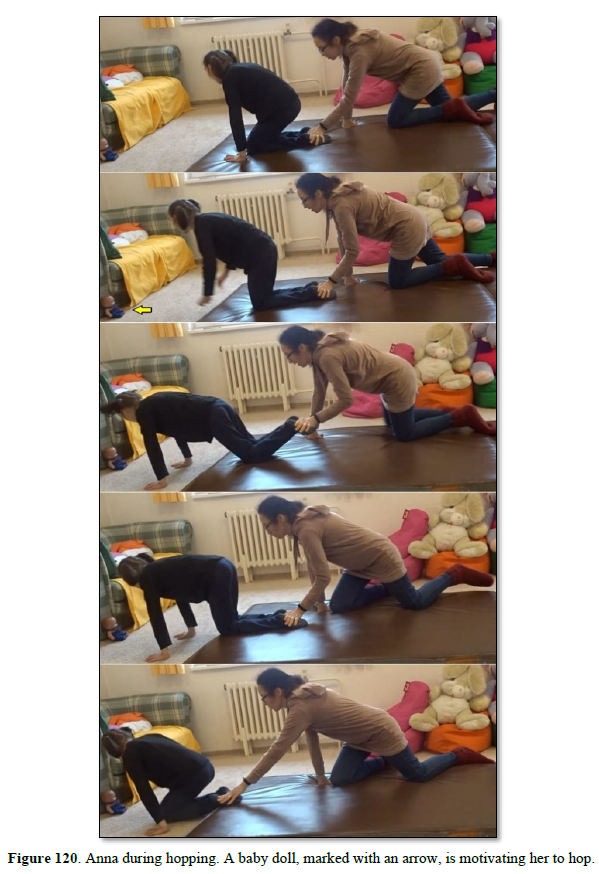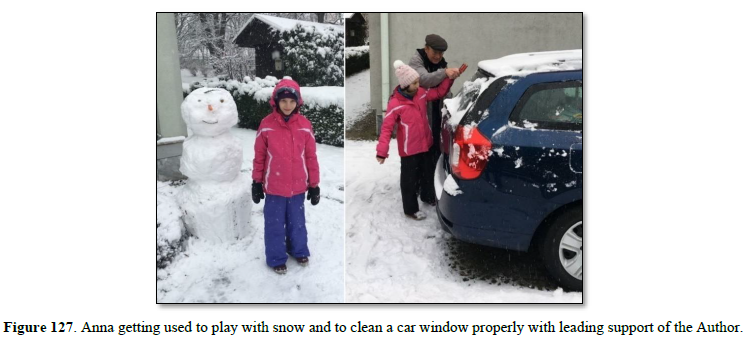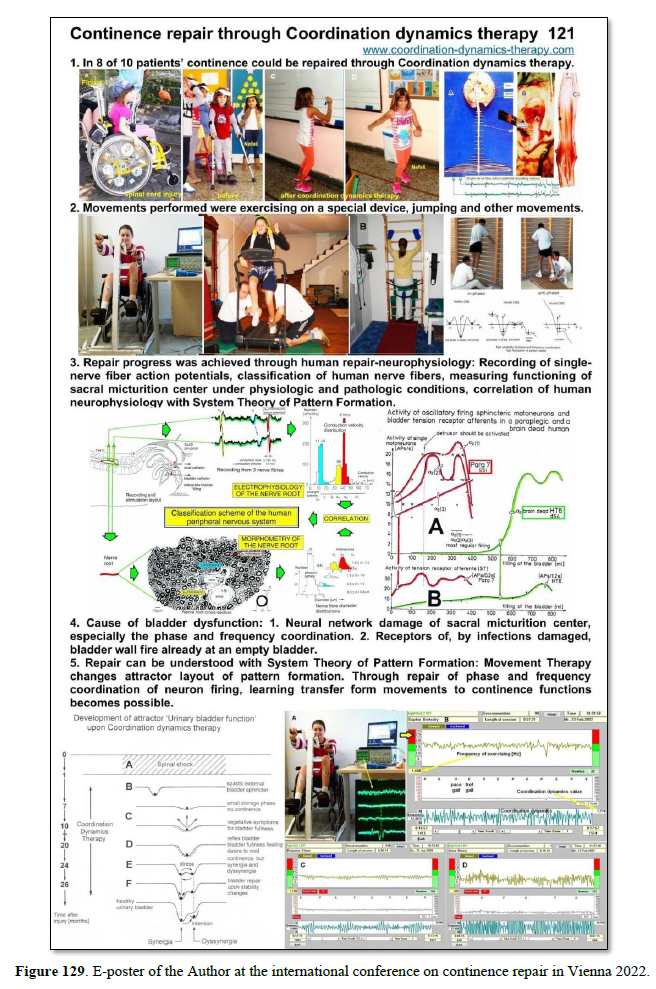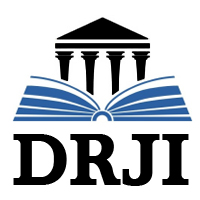Research Article
Genetic Disease Repair (5p-) Through Coordination Dynamics Therapy I
364
Views & Citations10
Likes & Shares
The 9.5-year-old patient Anna with severe cri-du-chat syndrome learned creeping, crawling, up righting, walking, running, jumping and climbing staircases through 4.1 months of rather optimal coordination dynamics therapy (CDT). The emotional pattern crying and laughing became operational. It is the first time that a real progress through therapy is published in this genetic disease. The lost piece of chromosome 5 included 5p15.1 through 5p15.33. Vojta, Bobath, and exercising on the “Locomat” did not improve Anna. Only low-intensity CDT at an age between 5.5 to 9.5 years made her walking a few steps. It cannot be excluded that with this optimal 4.1-months CDT at an age of 9.5 years, genetic plasticity started to take place and not only a repair of the malformed central nervous system (CNS) caused by pathologic development due to the genetic disease. This coordinated-movement-based learning therapy seemed to be capable of targeting the epigenome and altering gene expression and hence to repair the CNS in Anna, especially in the phase of super-coordination. The possibility of repair through gene expression changes is supported by CNS repair through CDT in traumatic brain injury, spinal cord injury, stroke, Parkinson, spina bifida, cerebral palsy, coma patients, bladder incontinence, basal ganglia injury, spinal muscular atrophy and cancer growth inhibition. Even though cognitive functions improved, Anna did not learn so far to speak, apart from the three words mama, tata and baba, and to read, write and calculate.
CDT was developed within 36 years on the basis of human repair-neurophysiology, including human anatomy, human neurophysiology and CNS repair data of human patients. The anatomy of the cauda equina nerve roots, down to teased nerve fiber dissections, were clarified to develop the single-nerve-fiber action potential recording method to measure simultaneously the natural impulse pattern of single-nerve fibers running in and out of the CNS and analyze human CNS functioning. With the discovered phase and frequency coordination among neurons for neural network organization, which becomes impaired following injury, malformation and degeneration, CDT was developed to repair the impaired phase and frequency coordination and induce plasticity by using coordinated movements from phylogeneses and ontogenesis. By combining human repair-neurophysiology with the System Theory of Pattern Formation and using a special CDT device for coordination treatment and measurements of arm and leg movements, the progress in CNS repair could objectively be quantified by a single-coordination dynamics value, which could be compared with existing values of healthy children.
Keywords: Human repair-neurophysiology, Single-nerve fiber action potentials, Neural network organization, Phase and frequency coordination, System theory of pattern formation, Coordination dynamics therapy, Continence, Genetic disease repair, Super-coordination phase
- Schalow G (2013) Human Neurophysiology: Development and Repair of the Human Central Nervous System. Nova Science Publishers, Inc, Hauppauge NY, USA, pp: 734.
- Schalow G (2015) Repair of the Human Brain and Spinal Cord. Nova Science Publishers, Inc, Hauppauge NY, USA, pp: 525.
- Schalow G (2015) Neural network learning in human. Nova Science Publishers, Inc, Hauppauge NY, USA, pp: 324.
- Schalow G (2002) Stroke recovery induced by coordination dynamic therapy and quantified by the coordination dynamic recording method. Electromyogr Clin Neurophysiol 42: 85-104.
- Schalow G (2002) Improvement after traumatic brain injury achieved by coordination dynamic therapy. Electromyogr Clin Neurophysiol 42: 195-203.
- Schalow G, Jaigma P (2006) Improvement in severe traumatic brain injury induced by coordination dynamics therapy in comparison to physiologic CNS development. Electromyogr Clin Neurophysiol 46: 195-209.
- Schalow G (2019) Regeneration of the human spinal cord via coordination dynamics therapy. Peertechz Publications, pp: 97.
- Schalow G (2009) Partial cure achieved in a patient with near-complete cervical spinal cord injury (95% injury) after 3 years of coordination dynamics therapy. Electromyogr Clin Neurophysiol 49: 199-221.
- Schalow G (2002) Recovery from spinal cord injury achieved by 3 months of coordination dynamic therapy. Electromyogr Clin Neurophysiol 42: 367-376.
- Schalow G (2003) Partial cure of spinal cord injury achieved by 6 to 13 months of coordination dynamic therapy. Electromyogr Clin Neurophysiol 43: 281-292.
- Schalow G, Jaigma P, Belle VK (2009) Near-total functional recovery achieved in partial spinal cord injury (50% injury) after 3 years of coordination dynamics therapy. Electromyogr Clin Neurophysiol 49: 67-91.
- Schalow G (2010) Cure of urinary bladder functions in severe (95%) motoric complete cervical spinal cord injury in human. Electromyogr Clin Neurophysiol 50: 155-179.
- Schalow G (2021) CNS Repair in a Girl with a Spinal Cord Injury. Adv Public Health Com Trop Med 121: 201-226.
- Schalow G (2006) Cerebellar injury improvement achieved by coordination dynamics therapy. Electromyogr Clin Neurophysiol 46: 433-439.
- Schalow G (2021) Cure-like brain-repair in a girl with atrophied cerebellum and pons through Coordination Dynamics Therapy. Adv Public Health Com Trop Med 123: 1-47.
- Schalow G, Jaigma P (2005) Cerebral palsy improvement achieved by coordination dynamics therapy. Electromyogr Clin Neurophysiol 45: 433-445.
- Schalow G (2006) Hypoxic brain injury improvement induced by coordination dynamics therapy in comparison to CNS development. Electromyogr Clin Neurophysiol 46: 171-183.
- Schalow G, Pääsuke M, Ereline J, Gapeyeva H (2004) Improvement in Parkinson’s disease patients achieved by coordination dynamics therapy. Electromyogr Clin Neurophysiol 44: 67-73.
- Schalow G, Nyffeler T (2001) Koordinationsdynamik-Therapie: Myelomeningozele (Spina bifida). Physiotherapie.
- Schalow G, Nyffeler T (2000) Koordinatiosdynamik-Therapie: Skoliose. Physiotherapy.
- Schalow G (2019) Permanent coma patient re-learned to speak via Coordination Dynamics Therapy. Arch Clin Med Case Rep 3(2): 33-50.
- Schalow G (2017) Breast cancer growth inhibition via Coordination Dynamics Therapy. In: “Horizons in Cancer Research. Volume 68”. Editor: Hiroto S. Watanabe. Nova Science Publishers, Inc, Hauppauge NY, USA, pp: 125-151.
- Schalow G (2020) Anaplastic oligodendroglioma WHO III brain cancer-patient recovered following operation, radiation and chemotherapy through Coordination Dynamics Therapy, which is also a Covid-19 treatment without ventilator. Int J Med Clin Imaging 5(2): 165-210.
- Christensen JF, Jones LW, Andersen JL, Daugaard G, Rorth M, et al. (2014) Muscle dysfunction in cancer patients. Ann Oncol 25: 947-958.
- Schalow G (2020) To live longer with a better quality of life through coordination dynamics therapy especially in patients with severe brain injury and brain-cancer. Int J Med Clin Imaging 5(2): 118-155.
- Schalow G (2021) Euthanasia in organ donation can be avoided through Coordination dynamics therapy. Adv Public Health Com Trop Med APCTM-132 3: 1-34.
- Schalow G (2022) Basal ganglia and cortex repair through human-repair neurophysiology 12 years after hypoxia during birth. In Schalow G (Ed) Human Repair-Neurophysiology, pp: 181-227.
- Schalow G (2022) Spinal muscular atrophy repair through Coordination dynamics therapy and Translation of frog neuromuscular innervation pattern changes caused by neurotrophins to human. Med AOASM-160 2022(2): 1-81.
- Schalow G (2022) Continence Repair Through Coordination Dynamics Therapy. Adv Public Health Com Trop Med.
- Schalow G (2023) Continence Repair through Neural Network Learning. Int J Med Clin Imaging 8(1): 433-476.
- Deisseroth K, Singla S, Toda H, Monje M, Palmer TD, et al (2004) Excitation-neurogenesis coupling in adult neural stem/progenitor cells. Neuron 42: 535-552.
- Schalow G (1985) The problem of Cauda equina nerve root identification. Zentralbl Neurochir 46: 322-330.
- Schalow G, Aho A, Lang G (1987) Nerve fiber counts for an intercostal nerve to cauda equina nerve root anastomosis. Zentralbl Chir 112: 457-461.
- Schalow G (1989) Efferent and afferent fibers in human sacral ventral nerve roots: Basic research and clinical implications. Electromyogr Clin Neurophysiol 29: 33-53.
- Schalow G (1987) Single unit potential amplitude in relation to the conduction velocity in frog and human. Zentralbl Neurochir 48: 109-113.
- Johannson RS (1978) Tactile sensibility in the human hand: Receptive field characteristics of mechanoreceptive units in the glabrous skin area. J Physiol 281: 101-123.
- Vallbo AB, Hagbarth K-E, Torebjörk HE, Wallin BG (1979) Somatosensory proprioceptive, and sympathetic activity in human peripheral nerves. Physiol Rev 59: 919-957.
- Schalow G, Lang G (1987) Recording of Single Unit Potentials in Human Spinal Nerve Roots: A New Diagnostic Tool. Acta Neurochir 86: 25-29.
- Schalow G, Lang G (1989) Electrodiagnosis of human dorsal sacral nerve roots by recording afferent and efferent extracellular action potentials. Neurosurg Rev 12: 223-232.
- Paintal AS (1966) The influence of diameter of medullated nerve fibers of cats on the rising and falling phases of the spike and its recovery. J Physiol 184: 791-811.
- Huxley AF, Stämpfli R (1949) Evidence for saltatoric conduction in peripheral myelinated nerve fibers. J Physiol 108: 315-339.
- Rasminski M, Kearney RE, Aguayo AJ, Bray GM (1978) Conduction of nerve impulses in spinal nerve roots and peripheral nerves of dystrophic mice. Brain Res 143: 71-85.
- Schalow G (1991) Conduction velocities and nerve fibre diameters of touch, pain, urinary bladder and anal canal afferents and α and γ-motoneurons in human dorsal sacral roots. Electromyogr Clin Neurophysiol 31: 265-296.
- Schalow G, Zäch GA, Warzock R (1995) Classification of human peripheral nerve fibre groups by conduction velocity and nerve fibre diameter is preserved following spinal cord lesion. J Auton Nerv Syst 52: 125-150.
- Schalow G (2020) Classification and Identification of Human Peripheral Nerve Fibers by Conduction Velocity, Nerve Fiber Diameter and Natural Firing Patterns with Consequences for CNS Repair and Covid-19 Infection Treatment. Int J Med Clin Imaging 5(3): 231-314.
- Schalow G, Wattig B (1993) Recruitment of α and γ-motoneurons in rats, dogs and humans. Electromyogr Clin Neurophysiol 33: 387-400.
- Schalow G, Bersch U, Göcking K, Zäch GA (1995) Detrusor-sphincteric dyssynergia in paraplegia compared with the synergia in a brain-dead human by using the single-fiber action potential recording method. J Auton Nerv Syst 52: 151-180.
- Schalow G, Bersch U, Michel D, Koch HG (1995) Detrusor-sphincteric dyssynergia in humans with spinal cord lesions may be caused by a loss of stable phase relations between and within oscillatory firing neuronal networks of the sacral micturition center. J Auton Nerv Syst 52: 181-202.
- Schalow G (1992) Impulse pattern, innervation densities and two-point discrimination of skin and mucosal afferents in humans. Considerations for a sensory reinnervation of urinary bladder and anal canal in spinal cord lesions. IV (IV). Electromyogr Clin Neurophysiol 32: 259-285.
- Schalow G (1993) Impulse patterns of single encoding sites of human secondary muscle spindle afferents. Electromyogr Clin Neurophysiol 33: 451-464.
- Schalow G (2005) Tapering of human nerve fibers. Gen Physiol Biophys 24: 427-448.
- Schalow G, Zäch GA (1994) Nerve compound action potentials analyzed with the simultaneously measured single fiber action potentials. Electromyogr Clin Neurophysiol 34: 451-465.
- Schalow G (1993) Recruitment of motoneurons in the occasional firing mode in paraplegics. Electromyogr Clin Neurophysiol 33: 401-408.
- Schalow G (1991) Oscillatory firing of single human sphincteric α2 and α3-motoneurons reflexly activated for the continence of urinary bladder and rectum - restoration of urinary bladder function in paraplegia. Electromyogr Clin Neurophysiol 31: 323-355.
- Schalow G (1993) Spinal oscillators in man under normal and pathologic conditions. Electromyogr Clin Neurophysiol 33: 409-426.
- Schalow G (2005) Tremor in Parkinson’s disease patients can be induced by uncontrolled activation and uninhibited synchronization of α2-motoneuron firing to which α1-motoneuron firing synchronizes. Electromyogr Clin Neurophysiol 45: 393-406.
- Schalow G, Pääsuke M, Jaigmy P (2005) Integrative re-organization mechanism for reducing tremor in Parkinson’s disease patients. Electromyogr Clin Neurophysiol 45: 407-415.
- Schalow G, Zäch GA (1998) Neuronal reorganization through oscillator formation training in patients with CNS lesions. J Periph Nerv Syst 3: 165-188.
- Schalow G (1993) Action potential patterns of intrafusal γ and parasympathetic motoneurons, secondary muscle spindle afferents and an oscillatory firing α2-motoneuron, and the phase relations among them in humans. Electromyogr Clin Neurophysiol 33: 477-503.
- Boyd IA (1980) The isolated muscle spindle. Trends Neurosci 3: 258-265.
- Gladden MH (1985) Efferent control of human muscle spindles. In: Boyd IA and Gladden MH (Eds.), The Muscle Spindle, Stockton Press, New York, pp: 243-254.
- Schalow G (2009). The classification and identification of human somatic and parasympathetic nerve fibers including urinary bladder afferents is preserved following spinal cord injury. Electromyogr Clin Neurophysiol 49: 263-286.
- Hess WR (1981) Biological order and human society. In: Akert, K. (Ed.), Biological Order and Brain Organization - Selected Works of W.R. Hess, Springer-Verlag, Berlin, pp: 3-15.
- Schalow G, Zäch GA (1996) Reflex stimulation of continuously oscillatory firing a and g-motoneurons in patients with spinal cord lesion. Gen Physiol Biophys 15(Suppl.1): 75-93.
- Schalow G (2010) Scientific basis for learning transfer from movements to urinary bladder functions for bladder repair in patients with spinal cord injury. Electromyogr Clin Neurophysiol 50: 229-395.
- Schalow G (2009) Coordination impairment between the somatic and parasympathetic nervous system divisions in the human sacral micturition center following spinal cord injury. Electromyogr Clin Neurophysiol 49: 337-367.
- de Groat WC (1975) Nervous control of the urinary bladder of the cat. Brain Res 87: 201-211.
- Torrens M, Morrison JFB (1987) The Physiology of the Lower Urinary Tract, Springer Verlag.
- Arbuthnott ER, Gladden MH, Sutherland F (1982) Autonomic innervation of muscle spindles from the hindlimb of the cat. Suppl Proc Roy Soc 17: 1.
- Barker D, Banks RW (1986) The muscle spindle. In: Engel AE and Banker, B.Q. (Eds.), Myology, Vol. 1, Part 1, McGraw-Hill, New York, pp: 309-341.
- Passatore GM, Fillipi GM, Grassi G (1985) Cervical sympathetic nerve stimulation can induce an intrafusal muscle fibre contraction in the rabbit. In: Boyd IA and Gladden MH (Eds.), The Muscle Spindle, Stockton Press, New York, pp: 221-226.
- Swash M, Fox KP (1985) Adrenergic innervation of baboon and human muscle spindles. In: Boyd IA and Gladden MH (Eds.), The Muscle Spindle, Stockton Press, New York, pp: 121-126.
- Baehr M, Frotscher M (2005) Duus‘Topical Diagnosis in Neurology. Thieme Verlag, Stuttgart. (a very good book for medical neuroscience since it correlates structure and function in human nervous system injuries).
- Schalow G, Zäch GA (1993) Control of oscillatory firing sacral sphincteric motoneurons (FR) by secondary muscle spindle afferents in humans. Poster 322.29/P at the XXXIInd International Congress of Physiological Sciences in Glasgow.
- Sperry RW (1945) The problem of central nervous system reorganization and muscle transposition. Quart Rev Biol 20: 311-369.
- Sperry RW (1947) Effect of crossing nerves to antagonistic limb muscles in the monkey. Arch Neurol Psychiat (Chicago) 58: 452-473.
- Weiss P, Brown PF (1941) Electromyographic study on coordination of leg movements in poliomyelitis patients with transposed tendons. Proc Soc Exper Biol Med 48: 384-387.
- Keirstead HS, Nistor G, Bernal G, Totoiu M, Cloutier F, et al. (2005) Human embryonic stem cell derived oligodendrocyte progenitor cell transplants remyelinate and restore locomotion after spinal cord injury. J Neurosci 25: 4694-4705.
- Martino G, Pluchino S (2006) The therapeutic potential of neural stem cells. Nat Rev Neurosci 7: 395-406.
- McDonald JW, Liu XZ, Qu Y, Liu S, Mickey SK, et al. (1999) Transplanted embryonic stem cells survive, differentiate and promote recovery in injured rat spinal cord. Nature Med 5: 1410-1412.
- Kerschensteiner M, Schwab ME, Lichtman JW, Misgeld T (2005) In vivo imaging of axonal degeneration and regeneration in the injured spinal cord. Nature Med 11: 572-577.
- Editorials: Order from chaos (2010) Nature 466: 7-8.
- Maier IC, Schwab ME (2006) Sprouting and circuit formation in the injured spinal cord: Factors and activity. Philos Trans R Soc Lond B Biol Sci 361: 1611-1634.
- Zorner B, Schwab ME (2010) Anti - Nogo on the go: From animal models to a clinical trial. Ann N Y Acad Sci 1198Suppl.1: E22-E34.
- Thuret S, Moon LDF, Gage FH (2006) Therapeutic interventions after spinal cord injury. Nat Rev Neurosci 7: 628-643.
- Bradbury EJ, McMahon SB (2006) Spinal cord repair strategies: Why do they work? Nat Rev Neurosci 7: 644-653.
- Harel NY, Strittmatter SM (2006) Can regenerating axons recapitulate developmental guidance during recovery from spinal cord injury. Nat Rev Neurosci 7: 603-616.
- Kelso JAS (1995) Dynamic Patterns. The Self-Organization of Brain and Behavior. MIT Press, Cambridge.
- Haken H, Kelso JA, Bunz H (1985) A theoretical model of phase transitions in human hand movements. Biol Cybern 39: 139-156.
- Zanone PG, Kelso JAS (1992) Evolution of behavioral attractors with learning: Nonequilibrium phase transition. J Exp Psychol Hum Percept Perform 18(2): 403-421.
- Eriksson PS, Perfilieva E, Björk-Eriksson T, Alborn AM, Nordborg C, et al. (1998) Neurogenesis in the adult human hippocampus. Nature Med 4: 1313-1317.
- Praag van H, Kempermann G, Gage H (1999) Running increases cell proliferation and neurogenesis in the adult mouse dentate gyrus. Nature Neurosci 2(3): 266-270.
- Schalow G (2009) Building of New Motoneurons in the Human Spinal Cord upon Coordination Dynamics Therapy to Improve Finger Functions in Motoric Complete Cervical Spinal Cord Injury. In: Berkovsky, T.C. (Ed.), Handbook of Spinal Cord Injuries, Chapter 4. Nova Science Publishers pp: 231-264.
- Drapeau E, Montaron MF, Aguerre S, Abrous DN (2007) Learning-induced survival of new neurons depends on the cognitive status of aged rats. J. Neurophysiol 27: 6037-6044.
- Zhao C, Deng W, Gage FH (2008) Mechanisms and functional implications of adult neurogenesis. Cell 132: 645-660.
- Colvis CM, Pollok JD, Goodman RH, Impey S, Dunn J, et al. (2005) Epigenetic mechanisms and gene networks in the nervous system. J Neursci 25(45): 10379-10379.
- Piper MC, Darrah J (1994) Motor Assessment of the Developing Infant. W.B. Saunders Company.
- Thelen E, Smith LB (1994) A dynamic approach to the development of cognition and action. MIT Press, Cambridge.
- Daeschler EB, Shubin NH, Jenkins FA (2006) A Devonian tetrapod-like fish and the evolution of the tetrapod body plan. Nature 440(7085): 757-763.
- Neil S (2008) Your inner fish: A journey into the 3.5-billion-year history of the human body. University of Chicago Press, New York.
- Shubin NH, Daeschler EB, Jenkins FH (2014) Pelvic girdle and fin of Tiktaalik roseae. Proc Natl Acad Sci 111: 893-899.
- Friedenreich CM, Cust AE (2008) Physical activity and breast cancer risk: impact of timing, type and dose of activity and population subgroup effects. Br J Sports Med 42: 636-647.
- Gould SJ (1977) Ontogeny and Phylogeny. Cambridge, Massachusetts: The Belknap Press of Harvard University Press.
- Mainardi PC (2006) Cri du Chat syndrome. In: Orphanet. J Rare Dis 1: 2006.
- Schalow G, Yamamura M (1971) Investigation of ground state correlation in an extended Lipkin-Meshkov-Glick-Modell. Nuclear Physics A161: 93-104.
QUICK LINKS
- SUBMIT MANUSCRIPT
- RECOMMEND THE JOURNAL
-
SUBSCRIBE FOR ALERTS
RELATED JOURNALS
- International Journal of Internal Medicine and Geriatrics (ISSN: 2689-7687)
- Journal of Nursing and Occupational Health (ISSN: 2640-0845)
- International Journal of Diabetes (ISSN: 2644-3031)
- Journal of Otolaryngology and Neurotology Research(ISSN:2641-6956)
- Journal of Allergy Research (ISSN:2642-326X)
- Archive of Obstetrics Gynecology and Reproductive Medicine (ISSN:2640-2297)
- BioMed Research Journal (ISSN:2578-8892)





